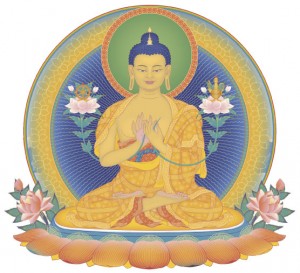The Dharma, along with the
Buddha and Sangha, is one of the three Jewels - the objects of refuge for all Buddhists.
The Dharma Jewel is sometimes visualised as a Metaphysical Crystal with 84,000 different
facets, representing all the teachings of the Buddha. Depending on our viewpoint, one or a
few of these facets will
reflect brightly in our direction.
When we first meet the Dharma, we are attracted to the most brilliantly reflecting facets
- those aspects of the teachings that are particularly relevant to us and our problems.
Most of the other facets will appear dull or oblique, or not appear to us at all, being
completely hidden round the other side of the Crystal.
But other people may be attracted to those facets of the Jewel that appear bright to them
but dull or hidden to us. We must be very careful before making any comparisons, because
the appearance of the Jewel to our mind is entirely a result of our karma.
Sometimes, with the zeal of the convert, the new Buddhist may think that her school of
Buddhism provides the best path to enlightenment for all sentient beings to follow.
But her senior Sangha will quickly explain that no facet of the Precious Jewel is
inherently superior to, nor brighter than, any other. Only an enlightened being can see
the complete Metaphysical Crystal in its full glory - perpetually and brilliantly
radiating light from all its facets in all directions throughout this and all other
universes.
By understanding the true nature of the Jewel, the new convert will not become intolerant,
sectarian or exclusive, but will stand in awe of the Cosmic Vastness of the Dharma and the
way that the compassionate teachings of Awakened Mind are designed to reach all sentient
beings.
By contemplating the multifaceted aspects of the Dharma, Buddhists are protected from
sinking into sectarianism and bigotry.
Though there are hundreds of different schools of Buddhism, they all have their basis in
the Four Seals of The Dharma, and so
they coexist in friendship and mutual respect because they appreciate that different
people require different approaches to the Dharma:
Academics may be attracted by the intellectual and philosophical aspects such as the
critique of essentialism
and the profound teachings on emptiness.
Busy office workers may value the peace of mind and relief from information-overload
provided by meditation.
Other converts might have a more devotional inclination, for example to Arya Tara (a
manifestation of the feminine aspects of awakened mind). Devotion to The Venerable Lady Tara is especially
popular with people of both sexes and all orientations who have abandoned their previous
religion because of its institutionalised sexism and homophobia.
And of course, Buddhism is very much an 'Old
Tyme Religion' incorporating the Golden Rule, with a universal code of ethics requiring
kindness to all beings, both human and animal.
Peace and tolerance
The symbolism of the Dharma Jewel is one of the reasons that Buddhists
have never persecuted one another nor members of other religions. Buddhism is unique among
religions in the following respects:
- Buddhism is based on reason, experience
and tolerance - not dogma.
- Buddhism not only tolerates, but actually welcomes vigorous criticism. The Buddha
himself told potential students to challenge his teachings in the same manner that they
would examine, cut, burn, attempt to dissolve and analyse an ingot that was claimed to be
pure gold. Blind faith is not a virtue in Buddhism. The teachings must be
questioned if they are to be understood.
- Buddhism forbids 'holy' wars of conversion, or conversion by intimidation,
subjugation and dhimmitude.
- Buddhism completely rejects animal and human sacrifice. Buddhism does not burn and never
has burned heretics at the stake,
or beheaded hostages as
a religious ritual.
- Buddhism does not divide the world into the lands of true belief and the lands where
wars of rape
and pillage may be waged with divine approval.
- Buddhism absolutely forbids terrorism. No ritual beheadings. No execution of
apostates. No genocide. No
fatwas. No jihads.
And no reservations, no ifs and buts and no excuses.
- Buddhism does not attempt to suppress scientific research or persecute scientists. There
is no Buddhist equivalent of the Galileo Auto da Fe, the Giordano Bruno burning, the Monkeyville
trial or present day Bible-belt
textbook censorship.
- Buddhism does not treat women as
chattels, or second class citizens created by God as an afterthought.
- Buddhism forbids lying, or the use of disinformation
to propagate its teachings.
- Buddhism does not regard non-Buddhists as 'Pagans', 'Heathens', 'Dhimmis', 'Kaffirs', or
other derogatory terms for subhumans to be enslaved, exploited and/or exterminated.
Facets of the three jewels
Buddhist Resources |
